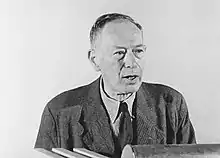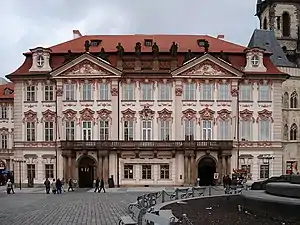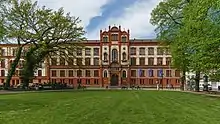Emil Utitz
Emil Utitz (27 May 1883 – 2 November 1956) was a Czech philosopher and psychologist of Jewish descent. He was educated in Prague, where he was a classmate of Franz Kafka. After studies in Munich, Leipzig, and Prague, he became a professor in Rostock, and from 1925 was Chair of Philosophy at the University of Halle-Wittenberg. After his forced retirement in 1933, he became a professor in Prague. In 1942, he was deported to Theresienstadt Ghetto, where he was head of the library. After the liberation of Theresienstadt in 1945, he returned to Prague. Utitz died in Jena in 1956, while travelling through East Germany to give lectures.
Emil Utitz | |
|---|---|
 Emil Utitz giving a lecture in Theresienstadt, still from the 1944 propaganda film Theresienstadt (photographer: Ivan Frič) | |
| Born | 18 May 1883 |
| Died | 2 November 1956 (aged 73) |
| Academic background | |
| Education | |
| Alma mater | Charles University |
| Thesis | Wilhelm Heinse und die Ästhetik zur Zeit der deutschen Aufklärung (1906) |
| Doctoral advisor | Christian von Ehrenfels |
| Influences | Franz Brentano |
| Academic work | |
| Discipline |
|
| Sub-discipline |
|
| Institutions | |
| Doctoral students | Hermann Boeschenstein |
Early life and education

Emil Utitz was born in Roztoky near Prague on 27 May 1883.[1] He grew up in Roztoky with his sister Flora.[2] Their parents were Gotthold Utitz (1855–1916),[2] a manufacturer of leather goods, and his wife Philippina.[3] A German-speaking Jew,[2] he was educated in Prague, first at a Piarist elementary school, then at the Altstädter Gymnasium secondary school in the Kinský Palace, where Franz Kafka was a classmate.[3] After passing his Matura, Utitz studied at the University of Munich. After starting with law in 1901, he moved on to philosophy, psychology, art history and archeology, returning to Prague to study at Charles University in 1903, where Anton Marty was one of his teachers. In 1904, he spent one semester at the University of Leipzig and took classes with Wilhelm Wundt and Johannes Volkelt.[4] He defended his PhD in 1906 under the supervision of Christian von Ehrenfels, with the thesis Wilhelm Heinse und die Ästhetik zur Zeit der deutschen Aufklärung (Wilhelm Heinse and aesthetics in the German Enlightenment).[5][6] During his studies, he was member of a philosophical circle, strongly influenced by Franz Brentano, that met at the Café Louvre and included Kafka and Oskar Kraus.[7][8]
Utitz also wrote poems. His Von des Lebens letzten Rätseln: Eine lyrische Symphonie in drei Sätzen (On Life's Final Mysteries: A Lyrical Symphony in Three Movements) appeared in 1902, and in the same year, he used the pseudonym Ernst Limé[9] to publish the collection Meine Hochburg (My Stronghold).[10]
Academic career

After his doctorate, Utitz travelled to Italy, spending time with Franz Brentano in Florence.[11] Supported by Max Dessoir, he found a teaching position at the University of Rostock in 1910 and obtained the habilitation qualification in November 1910.[5] Afterwards, he taught at a Prague secondary school for a few years.[12] Utitz married Ottilie Schwarzkopf, the daughter of a Jewish factory owner from Sušice, in 1914.[13] They had no children.[2] In 1916, he received a titular professorship at Rostock, becoming a regular tenured professor in 1924.[14] From October 1925, Utitz held a chair of philosophy at the University of Halle-Wittenberg as successor of Max Frischeisen-Köhler. Although he had converted to Protestantism,[15] he was considered Jewish in the context of the so-called Law for the Restoration of the Professional Civil Service and was suspended in April 1933, then forced into unpaid retirement in October 1933.[5] He returned to Prague, where he first worked on the Nachlass of Franz Brentano, then became the successor of Christian von Ehrenfels as Chair of Philosophy at the German University of Prague in October 1934.[5][12] He was forcibly retired in 1938 after arguments with Nazi colleagues.[5]
His PhD students include Hermann Boeschenstein (Die Aesthetik des J. P. de Crousaz, The Aesthetics of J. P. de Crousaz, Rostock 1924)[16][17] and Johannes Güthling (Vergleichende Untersuchungen über das Augenmaß für Strecken und Flächen, Comparative Studies of the Visual Judgement for Distance and Area, Halle 1927).[18]
Utitz's works include books on art theory, aesthetics, characterology and cultural philosophy, as well as books about Brentano and Egon Erwin Kisch.[9][19]
Theresienstadt
Utitz and his wife were deported to Theresienstadt Ghetto on 30 July 1942.[5][20] There, he became head of the Ghetto Central Library, which opened in November 1942.[21] The library started with about 4,000 books, most of them theological or scholarly works in Hebrew or German.[22] Within a year, the collection had grown to over 48,000 volumes. When the reading room opened in June 1943, use was restricted to readers who could pay a deposit and pass an interview with Utitz or another librarian.[23] Utitz, who was one of the "prominent" prisoners given special treatment, was involved in cultural activities in Theresienstadt, for example as judge in a poetry contest in 1944.[24][25] He also gave lectures, one of which was filmed for the 1944 propaganda film Theresienstadt.[26] The manuscript of Viktor Ullmann's opera Der Kaiser von Atlantis was saved by Utitz when Ullman was deported to Auschwitz in October 1944 and later given to H. G. Adler.[27] Utitz and his assistant, Käthe Starke-Goldschmidt, who preserved the Theresienstadt Papers,[28] were the only library staff to survive until the liberation of Theresienstadt in May 1945, and spent three more months in the camp to oversee the disbanding of the library, with 100,000 books returned to Prague.[29] Utitz later wrote a book about the psychology of life in Theresienstadt, which appeared in a Czech edition in 1947 and in German translation in 1948.[30]
Later life and death
After the liberation of Theresienstadt, he returned to Prague and was again named professor of philosophy at the university.[5] As emeritus professor, he lived in Smíchov.[2] Utitz became a member of the Communist Party of Czechoslovakia in 1948.[31] While travelling to give lectures in East Germany, he died in Jena on 2 November 1956 from a heart attack.[32]
References
Footnotes
- Karge 2011, p. 281.
- Burkhardt 1998, p. 38.
- Wolfradt, Billmann-Mahecha & Stock 2014, p. 454.
- Wolfradt, Billmann-Mahecha & Stock 2014, pp. 454–455.
- Wolfradt, Billmann-Mahecha & Stock 2014, p. 455.
- Matějčková 2020, p. 439.
- Trivium 2010.
- Smith 1997, pp. 85–86.
- Bergman 2007.
- Stach & Frisch 2016, p. 500.
- Burkhardt 1998, p. 141.
- Mehring 2003, p. 761.
- Karge 2011, p. 282.
- Kowitz 2017.
- Stone 2012, p. 87.
- Batts 2003.
- Milnes 1969, p. 1.
- Wolfradt, Billmann-Mahecha & Stock 2014, p. 153.
- Boeschenstein 1971.
- Peschel 2012, p. 220.
- Intrator 2007, p. 515.
- Intrator 2005, pp. 6–7.
- Intrator 2007, pp. 517–518.
- Intrator 2005, p. 25.
- Alfers 2010, p. 54.
- Adler 2017, p. 148.
- Modlinger 2015, p. 66.
- Meyer 2013, p. 319.
- Intrator 2007, pp. 520–521.
- Peschel 2012, p. 227.
- Bigler-Marschall 2017.
- Burkhardt 1998, p. 36.
Sources
- Adler, H. G. (2017) [1955]. Theresienstadt 1941–1945: The Face of a Coerced Community. Translated by Cooper, Belinda. Cambridge: Cambridge University Press. ISBN 978-0-521-88146-3.
- Alfers, Sandra (2010). "Poetry from the Theresienstadt Transit Camp, 1941–1945". Rocky Mountain Review. 64 (1): 47–70. ISSN 1948-2825. JSTOR 25677055.
- Batts, Michael S. (2003). König, Christoph; Wägenbaur, Birgit (eds.). Boeschenstein, Hermann. pp. 224–225. ISBN 978-3-11-090805-3. OCLC 861526253.
{{cite book}}:|work=ignored (help)CS1 maint: location missing publisher (link) - Bergman, Samuel Hugo (2007). "Utitz, Emil". In Skolnik, Fred (ed.). Encyclopaedia Judaica. Vol. 20. Detroit: Thomson/Gale. p. 445. ISBN 978-0-02-865928-2. OCLC 884641021.
- Bigler-Marschall, Ingrid (2017) [2005]. Utitz, Emil. ISBN 978-3-908255-25-3. Retrieved 13 October 2021.
{{cite encyclopedia}}:|work=ignored (help) - Boeschenstein, Hermann (1971). "Emil Utitz, der Philosoph aus dem Prager Kreis (1883–1960)". Rice University Studies. 57 (4): 19–32. hdl:1911/63065.
- Burkhardt, Liane (1998). "Versuch gegen das Vergessen.—Erste Schritte. Zu einigen Positionen des Geisteswissenschaftlers Emil Utitz (1883–1956)". Brücken. Germanistisches Jahrbuch Tschechien-Slowakei (in German). 06 (1–2): 33–60.
- Intrator, M. (1 January 2005). "The Theresienstadt Ghetto Central Library, Books and Reading: Intellectual Resistance and Escape During the Holocaust". The Leo Baeck Institute Yearbook. 50 (1): 3–28. doi:10.1093/leobaeck/50.1.3. ISSN 0075-8744.
- Intrator, Miriam (2007). ""People were literally starving for any kind of reading": The Theresienstadt Ghetto Central Library, 1942–1945". Library Trends. 55 (3): 513–522. doi:10.1353/lib.2007.0009. hdl:2142/3706. ISSN 1559-0682. S2CID 7030592.
- Karge, Wolf (2011). "Utitz, Emil". In Pettke, Sabine; Röpke, Andreas (eds.). Biographisches Lexikon für Mecklenburg (in German). Vol. 6. pp. 281–286. ISBN 978-3-7950-3750-5. OCLC 949837703.
- Kowitz, Jan (1 December 2017). "Utitz, Emil – Catalogus Professorum Rostochiensium". Catalogus Professorum Rostochiensium. Retrieved 7 September 2021.
- Matějčková, Tereza (18 May 2020). "Surviving the Holocaust: Emil Utitz's 'As-If Technique'". The European Legacy. 25 (4): 438–454. doi:10.1080/10848770.2020.1725367. ISSN 1084-8770. S2CID 214526383.
- Mehring, Reinhard (1 October 2003). "Das Konzentrationslager als ethische Erfahrung". Deutsche Zeitschrift für Philosophie (in German). 51 (5): 761–776. doi:10.1524/dzph.2003.51.5.761. ISSN 2192-1482. S2CID 172001981.
- Meyer, Beate (30 September 2013). A Fatal Balancing Act: The Dilemma of the Reich Association of Jews in Germany, 1939–1945. Berghahn Books. ISBN 978-1-78238-028-3.
- Milnes, Humphrey (1969). "Hermann Boeschenstein". German Life and Letters. 23 (1): 1–6. doi:10.1111/j.1468-0483.1969.tb00493.x. ISSN 1468-0483.
- Modlinger, Martin (1 March 2015). "Approaching Death: 'Last Writing' from the Terezín Ghetto". Oxford German Studies. 44 (1): 57–70. doi:10.1179/0078719114Z.00000000075. ISSN 0078-7191. S2CID 170677986.
- Peschel, L. A. (1 August 2012). ""A Joyful Act of Worship": Survivor Testimony on Czech Culture in the Terezin Ghetto and Postwar Reintegration in Czechoslovakia, 1945–48". Holocaust and Genocide Studies. 26 (2): 209–228. doi:10.1093/hgs/dcs032. ISSN 8756-6583.
- Smith, Barry (1 December 1997). "Brentano and Kafka". Axiomathes. 8 (1): 83–104. doi:10.1007/BF02681882. ISSN 1572-8390. S2CID 170253460.
- Stach, Reiner; Frisch, Shelley (2016). Kafka: The Early Years. Princeton: Princeton University Press. ISBN 978-1-4008-8447-6.
- Stone, Dan (2012). The Holocaust and Historical Methodology. Berghahn Books. ISBN 978-0-85745-492-8.
- Trivium (2 May 2010). "Emil Utitz". Trivium. Revue franco-allemande de sciences humaines et sociales – Deutsch-französische Zeitschrift für Geistes- und Sozialwissenschaften (in French). ISSN 1963-1820.
- Wolfradt, Uwe; Billmann-Mahecha, Elfriede; Stock, Armin (21 November 2014). Deutschsprachige Psychologinnen und Psychologen 1933–1945: Ein Personenlexikon, ergänzt um einen Text von Erich Stern (in German). Springer-Verlag. doi:10.1007/978-3-658-01481-0. ISBN 978-3-658-01481-0.